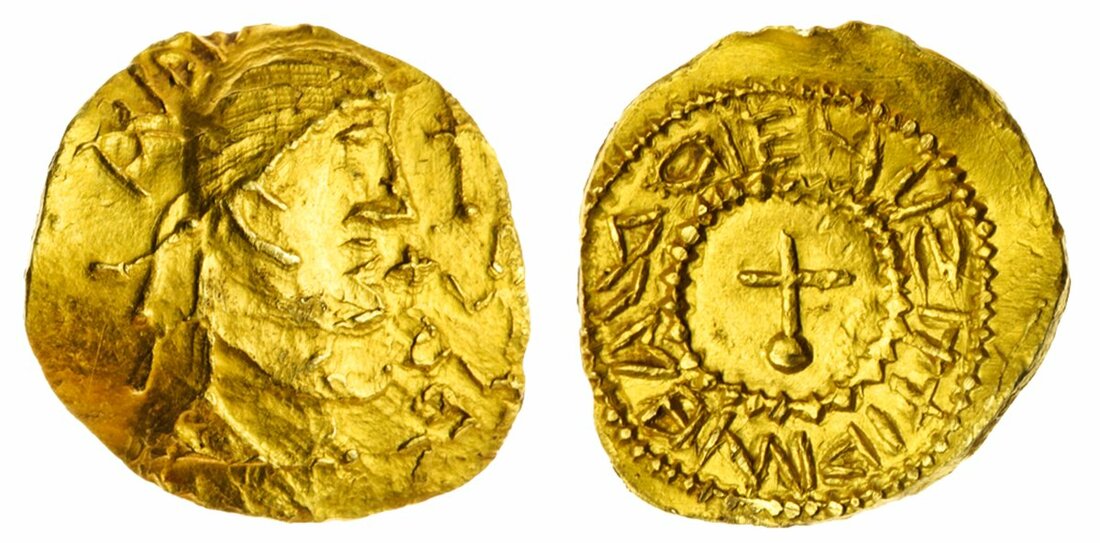
Auction: 21000 - The Tony Abramson Collection of Dark Age Coinage - Part I (conducted behind closed doors)
Lot: 18
Anglo-Saxon England, Kent, Eadbald (616-640), Gold Shilling (73% AV), 'Substantive Gold' Phase, struck AD 620-635, London, AVDV[ARLD RE]GES, the S inverted, diademed and draped bust right, cross before, rev. crucifix on globe within beaded border, 1.28g (SCBI 69 -; Dies A/c; Sutherland VI.1, no. 78; Metcalf 50; A&W xv; BNJ 89, North 29; Spink 758), obverse double-struck on a mildly concave and oversized flan and a slight contact mark to reverse at 6 o'clock, nevertheless a most attractive specimen, virtually as struck, the eighth presently known, extremely rare, and a coin of the utmost historical importance to British numismatics and probably initiated under the first Bishop of London
Spink 248, 25 September 2017, lot 688
~ Found at Billericay (Essex), 1 May 2017 ~
[EMC 2017.0175]
The Historical Context
According to Bede, Eadbald succeeded his father, Æthelberht, to ascend the throne of Kent in AD 616. Æthelberht was acclaimed for welcoming Augustine to his court in AD 597 and for his subsequent conversion to the Roman form of Christianity. However, Bede relates that soon after his accession, Eadbald apostatized, ejecting his Bishops - Mellitus was exiled to France - and incurring the Church's wrath by committing 'such fornication as the Apostle Paul mentioned as being unheard of even among the heathen, in that he took his father's [second] wife as his own.'
Ultimately, Eadbald relented, rejected his wife and was duly baptized, thereafter favouring the Church within his kingdom.
The subsequent spread of Christianity was facilitated by the use of a repertoire of Christian symbols on the coinage, though the later silver coinage evinces syncretic use of some Pagan motifs.
Literature and Interpretation
Sutherland was amongst the first to review the literature on the attribution to Eadbald. Shaw would further establish that Bede only used forms similar to that inscribed on the obverse of this coinage when quoting Pope Boniface, before subsequent discoveries such as that at Tangmere elicited further numismatic contributions from Blackburn and Williams. Deciphering elements of the reverse legend on the Pas-de-Calais and Hunterian specimens are taken to identify London as the mint.
The Coinage
There are sequence of historically significant events with Eadbald's reign that may point to the origins of this issue. Their overtly Christian elements likely point to personal moments in his life, such as his conversion by Laurentius, Archbishop of Canterbury in AD 616/17, or his foundation of a church latterly consecrated by Archbishop Mellitus. However they might also record wider events such as the death of Mellitus in AD 624, or even Paulinus's return to Kent in AD 634. Resolving this reverse legend is crucial to attribution. However conjectural an association to Mellitus may still be, a lifetime issue, would date the introduction of the coinage prior to AD 624.
One may even identify a 'common purpose' between brothers-in-law Eadbald and Edwin of Northumbria (lot 19). The erection of a Church could give occasion to issue a high-status coin. The driving force for this parallel initiative would then have come from the Roman bishops themselves, Mellitus and Paulinus, who would be more acquainted with the symbolism and usage of coins than the English kings.
The Corpus
1. Ashmolean Museum, Oxford, 1.26g, AV 69%, Crondall Hoard, 1828. (Dies A/a)
2. American Numismatic Society, New York, 1.29g, AV 64%, From the Norweb [SCBI 16, no. 42]; Lockett I, lot 206 and Grantley 595a Collections; Ponton D'Amecourt 658, Robert = Belfort 6527. Found Pas-de-Calais. (Dies A/b)
3. Fitzwilliam Museum, Cambridge, 1.27g, AV 72%, BNJ Coin Register 1998, 37. Found Tangmere, West Sussex, 1997. (Dies A/c)
4. British Museum, London, 1.28g, AV 74%, BNJ Coin Register 1998, 38. Found Shorne, Kent, 1998. (Dies A/d)
5. Dr. Andrew Wayne, 1.28g, AV 58%, CNG Triton XX, 10 January 2017, lot 1463; Spink 203, 24 June 2010, lot 1; Found near Deal, Kent, January 2010. (Dies A/d)
6. Hunterian Museum, Glasgow, 1.30g. cf. Bateson and Campbell, 1998, pp. 171, and pl. 28-29, no. 1. Dr Hunter bequest, 1783. A probable eighteenth century find. (Dies A/e)
7. Lord Stewartby, 1.28g, AV 67%, Spink 16019 (Part 1), 22 March 2016, lot 1; Bonhams, 16 October 2007, lot 325. (Dies A/d)
8. Abramson (EMC 2017.0175), 1.28g. 73% AV. Spink 17006, 25 September 2017, lot 688. Found Billericay, Essex, 1 May 2017. (Dies A/c)
ix) Fitzwilliam Museum, Cambridge (EMC 2001.1003), 1.29g, attributed to Eadbald, but apparently minted in Canterbury from different obverse die and reverse dies. Found Goodnestone, Kent, September 2001.
Subject to 20% VAT on Buyer’s Premium. Not applicable to "Buy Now " offerings. For more information please view Terms and Conditions for Buyers.
Sold for
£34,000
Starting price
£25000




